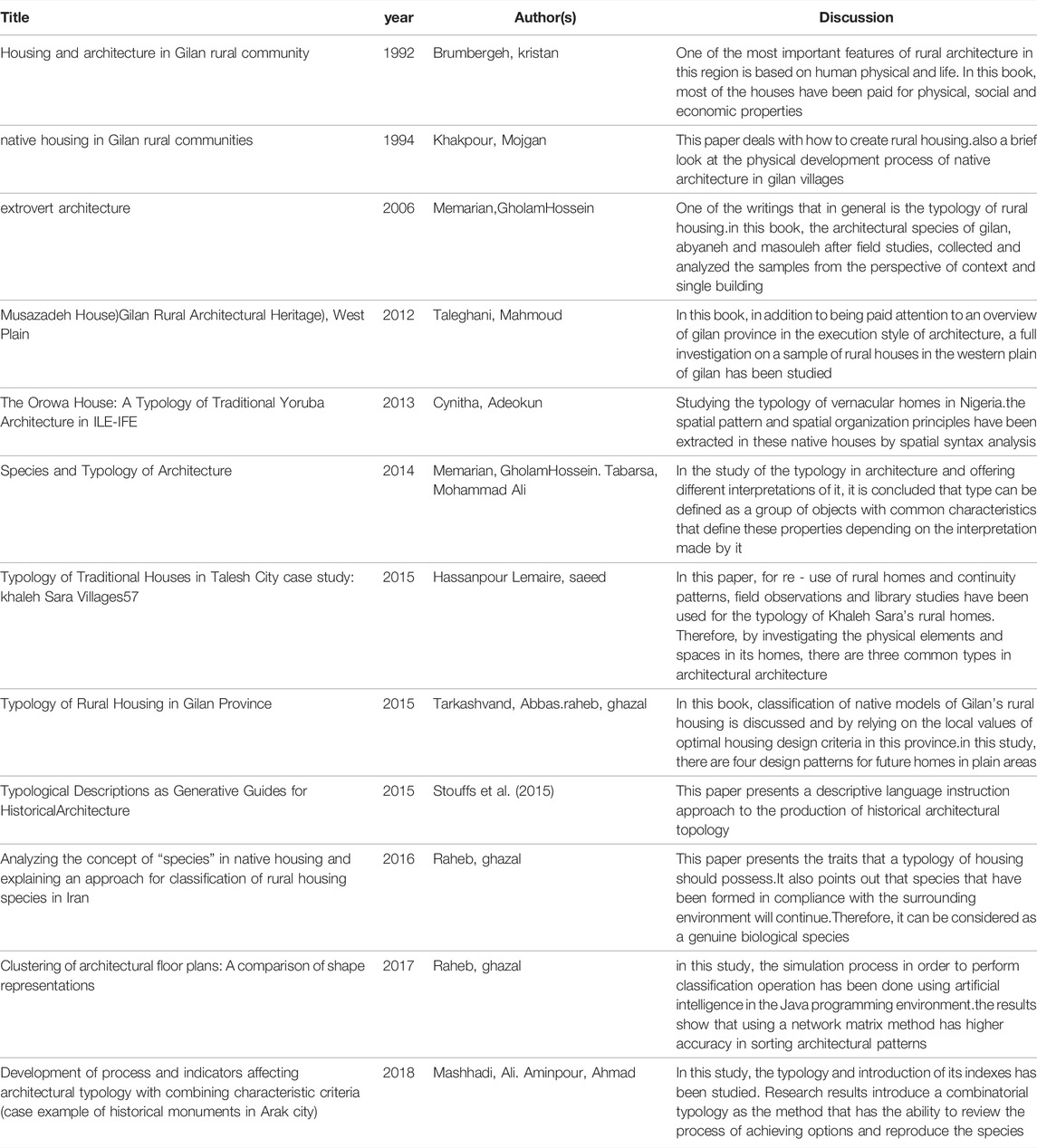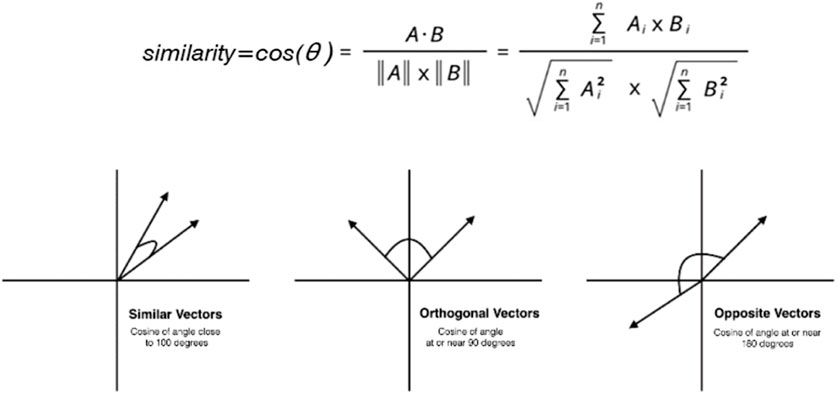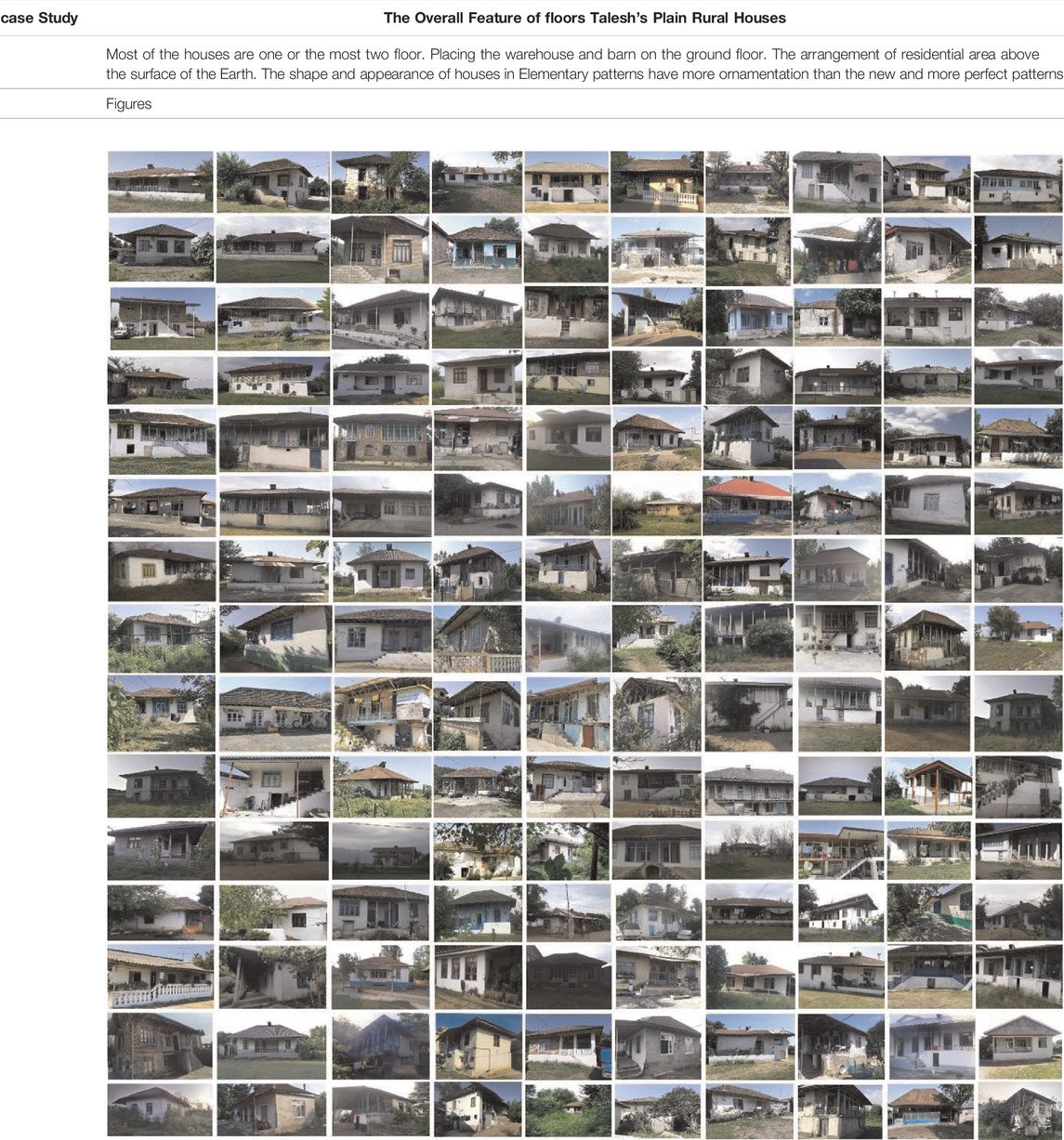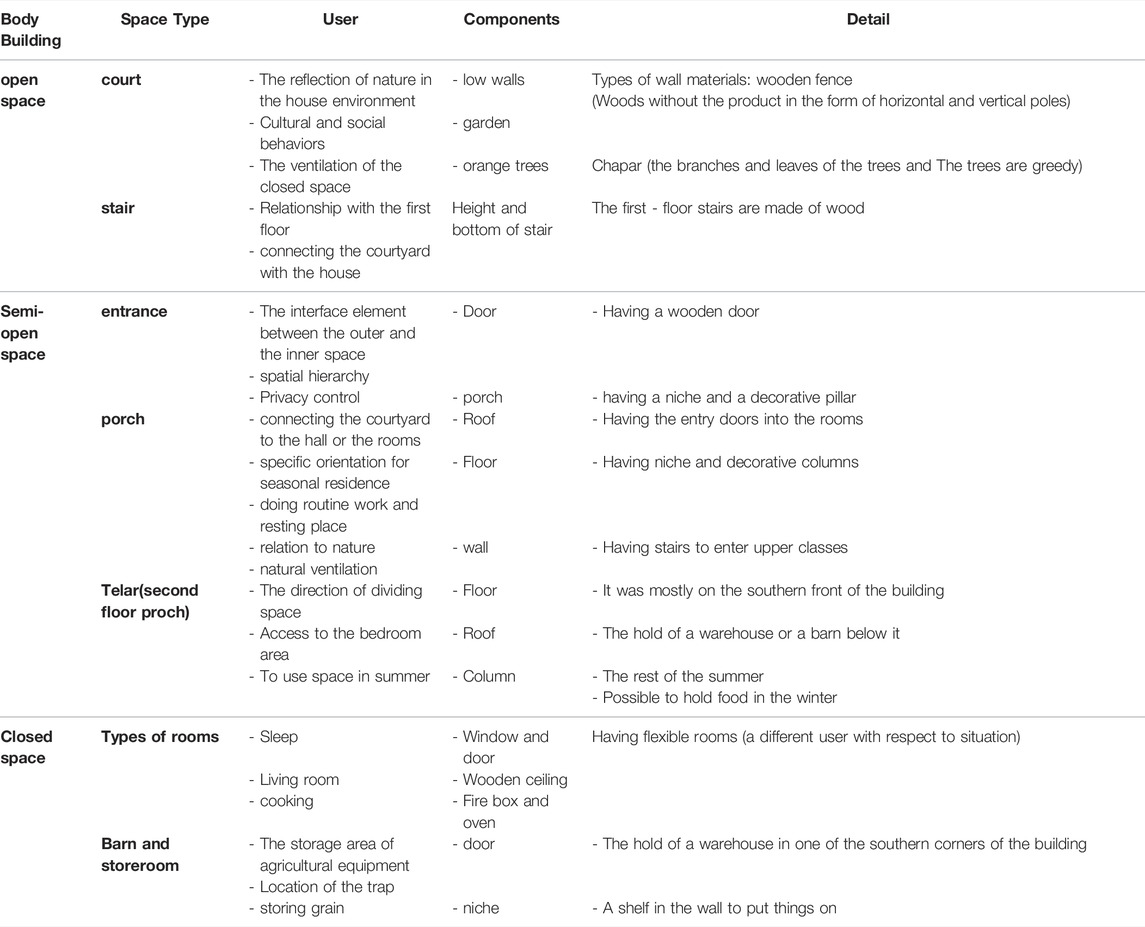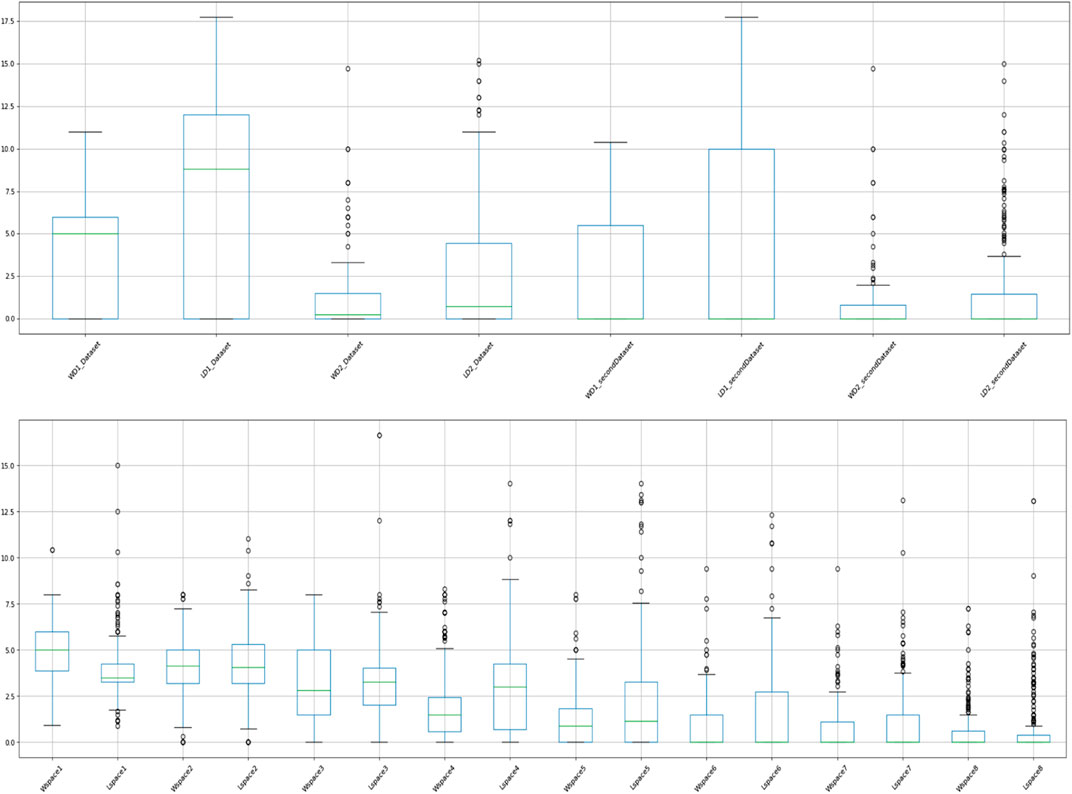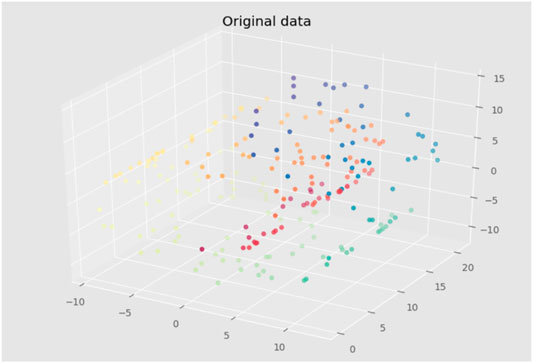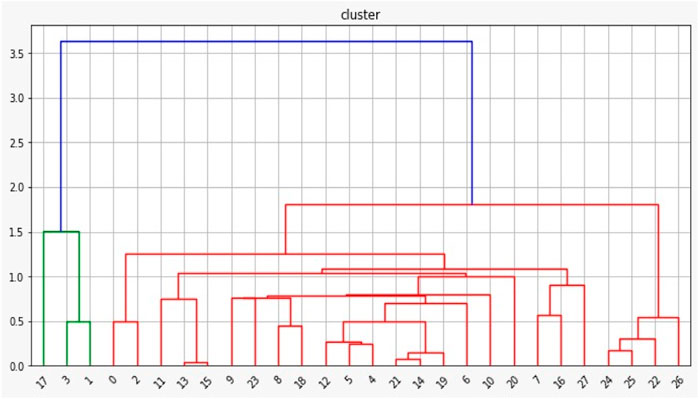- 1Department of Architecture, Kish International Branch, Islamic Azad University, Kish Island, Iran
- 2Department of Architecture, Tarbiat Modares University, Tehran, Iran
Housing is the most essential human need that in the past, rural houses have met this need well. Indigenous rural homes have undergone changes over time, some of which have been based on internal needs and needs, and some have been due to development and exogenous changes. One of the most critical steps to identify this type of change is the typology of indigenous homes; In this way, an essential step in the path of cognition, understanding and more coverage of this phenomenon is taken. Based on this, the present study intends to study and analyze the architectural types of houses in Talesh village, which originate from human nature, natural space and the bed in which they are formed. Therefore, to estimate the proportions and classification of the architectural plans of its houses, it is necessary to use a quantitative-qualitative research method. Mathematics is used in the Python programming language in data analysis. For this purpose, by selecting 150 samples of rural houses in the form of purposeful clusters and converting the created matrix from the dimensions and size of the plans to zero and one code, their similarity has been calculated. They are in close categories. Findings obtained by simulating the plans show that sloping roofs, building elevation, east-west orientation, porch, open plan and natural ventilation are common features in all indigenous houses. It is found in this area. Therefore, in general, the two architectural patterns in this area are one-story houses and Telar houses, in which high chair houses are a frequent type.
Introduction
Providing desirable rural housing in the country is an increasingly vital need (Raheb, 2016, 4). Today, forgetfulness and inattention to the architectural methods of the past have reduced the quality of rural housing. The study of indigenous houses as part of the great and fruitful treasure of the history and architectural culture of this land can make us aware of the economic and social conditions of the past. Cultural heritage has been passed on to future generations and has significantly impacted today’s buildings. Indigenous housing is well aware of the originality of life and environmental potentials. Instead of ignoring the needs of life and fighting geographical variables, Coordination has been formed with it (Sartipipour, 2011, 3; Motevalian and Yeganesh, 2020.).
Undoubtedly, the native architecture of Gilan, as a manifestation of art and beauty in the rural sector, has unique features that today can be used and expanded in design and planning in the housing sector. Attention and extraction of these concepts and principles not only increase the compatibility of residential buildings and structures with environmental and climatic conditions but also due to the creation and expansion of the cultural context of residents, is also effective in raising the quality of life (Yaran and Khoshbin, 2019, 16; Yeganeh and Kamalizadeh, 2018).
Studies show that a simple look at the past has led to traditional elements and has had detrimental consequences. A typology is an essential tool for abstracting these architectural patterns. Through a species- Comprehensive cognition provides access to abstract patterns of traditional architecture and the application in today’s architecture (Mashhadi and Aminpour, 2018, 174; Yeganeh 2020). Typology, which is used in various sciences to better classify and recognize its phenomena, is a critical concept in architecture and urban planning and has been studied by many authors. In his famous work (Architecture Book), Vitruvius grouped different Greek buildings, including houses, temples, and public buildings. The houses were sorted according to their location in the city and village (Architects, 2005 104). In the contemporary period, many architectural researchers such as Aldorossi, Argan, Imonino, Krayer have addressed this issue (Memarian and Dehghani Tafti, 2018, 1; Yeganeh, 2017; Apoorva et al., 2018; Rodrigues et al., 2013; Rodrigues et al., 2014).
In all studies in the world of architecture, species or “type” means a representative of a group of architectural organs with a physical aspect (architectural spaces, structures, decorations, materials, etc.) that with a specific mechanism, collection and categorization have achieved. The basis of this organization is based on common climatic elements, common geometric shapes, a common genetic code (genotype) and anything that can give the meaning of representation to identify other members of the group (Tusi Hoda and Iraj, 2019, 4). Accordingly, considering that the “classification system” typology is to express or want a series of limited connections between phenomena. Recognition and correct classification of different types of architecture can be useful in better understanding the space, its protection and access to new design methods (Hassanpourrmarr, 2014, 117; Norouzi et al., 2021). Because rural housing has direct, direct and robust lines of communication with the culture of the masses and with their daily lives. These buildings were built by people who have used all their intelligence and capacity to build them and all the existing relationships between They have used them in making them (Bazen and Bromberje, 1986; Bromberjeh, 1991; Haji Ebrahim Zargar, 1999; Elsayed et al., 2014; Bayegi et al., 2018).
For this purpose, regarding the improvement of rural housing situation due to the prevailing diversity of rural settlements, which is affected by various factors, this breadth and diversity of housing construction methods in rural areas requires comprehensive and macro information and provides a classification. It is accurate and comprehensive. As one of the innovative methods, algorithms can collect this information in a short time and a reasonable computational volume and find an optimal classification that increases the chances of finding better performance (Mazandzani and Reza, 2009; Kasmaei, 2006; Al Qady and Kandil, 2014). Accordingly, the purpose of this study is to provide a practical and usable approach to the classification of indigenous housing based on form, form and case in Talesh plain villages. Indigenous people in the rural context of Talesh city have collected and recorded information on 150 rural houses over 100 to 30 years (Figure 1). In fact, the research hypothesis is based on the fact that it is possible to use the algorithmic process with the help of supervised learning in the classification of house plans of the last one hundred years to answer the question that the classification of rural houses in Gilan What are the characteristics of form and form?
Research Background
Typology has long been the subject of numerous studies, and in architecture, as a step in understanding and classifying the common features and principles of phenomena, research has been done. Considering that the main issue raised in the present article is the extraction of formal and form features and classification to identify species based on form and shape, the study of thematic literature indicates the lack of studies in the field. In this research, it is cognitive that the typological process has been proposed by algorithmic method for analyzing the effects and recognizing them. For this purpose, to express the research background, an attempt was made to select those researches that are most similar to the research subject as research background by researching the scientific database. Therefore, the classification of some of the studies conducted in this article are (Table 1).
It should be noted that according to several sources, it can be said that although various studies have been conducted in the field of typology and the results of some of these studies, including HassanPourrmarr (2014), are consistent with the results of this study. Still, the survey in rural housing, using the algorithmic approach and data mining, which is in the process of rural housing design and preservation of past values, has been less studied. In the algorithmic method, by receiving unlimited data, different ideas can be easily examined simultaneously. Therefore, using this method in typology can create a proper relationship between input and output data and identify the influential factors. The accurate documentation of architectural patterns has more accurate estimation and helps achieve species recognition in less time.
Objective of the Research
The reflection of any society’s cultural, social, and religious roots is reflected in its architectural body. One of the essential features of rural architecture is to pay attention to the design by the natural needs of the people and the environment and their daily activities, such as the type of living spaces of the people. Architectural examples of the coexistence of living and living spaces in this type of housing are the depth of attention to people’s lives and needs, which has harmonized the physical space with the story of people’s lives. Such a view of life and attention to needs and harmony with the natural environment have led to various forms of housing. Accordingly, rural house architecture has many different data that must be categorized to extract relevant data.
Therefore, this study aims to classify the architecture of rural houses in the study area based on form and shape. It also proposes a new method for categorizing rural house plans based on an analogy between plan forms. The architecture of rural houses is based on the habits, needs, and desires of the people and has a lot of different data. Moreover, the house’s dimensions, size, and shape are some of the principles formed from the people’s desires over time. Also, with the data mining method, it is possible to simultaneously compare a more significant number of plans with the numerical data of architectural plans. The knowledge between them, a model of evolution in dimensions and dimensions, can be compared extracted. This pattern will show the evolution of the dimensions of common and non-common spaces, which can be compared to their evolution to reach an evolved form pattern. Therefore, in addition to the new needs of residents, inspire local architects and designers in designing rural homes (Verma and Thankur, 2010; Su and Yan, 2015; Torkashvand and Raheb, 2015).
Research Method
Rural housing, at least in its physical form, is the result of the interaction between human needs, including livelihood, cultural and biological, with the surrounding environment. Depending on the characteristics of the environment and human needs and capabilities, this relationship has a different quality. It, therefore, will be the source of the emergence of “different forms of housing.” Accordingly, the approach of the present study is to introduce the form of houses that are the product of a relationship that is established between human needs and the environment. Studying the formal features obtained, which are the product of these factors, and applying them in today’s world can be used in home improvement and renovation. Therefore, in this approach, the body of the building has been the focal point. Therefore, other aspects of the building related to other fields of science, such as sociology, economics, etc., can be studied in other studies.
In the field of typology, one of the purposes is to understand the set of information that exists within a type or species of the object and to ensure its survival to the internal information that lies in its space (Hillier and Hanson, 1984). the use of algorithmic technique With the help of a computer, it can help classify and analyze it. Because internal information in typology, such as house plans, can be converted into coding, algorithms and machine learning techniques can also be used. In artificial intelligence, the machine is allowed to observe a wide range of data in a specific field to perform operations such as decision making, classification and forecasting (Ashtari et al., 2021). The basis of the research method used in this research is proportional to its nature, which is considered applied research. Typology is a precise methodological process described below (Figure 2).

FIGURE 2. Cosine similarity formula and Angle representation of analogy vectors by cosine distance method (Garcia, 2018, 9).
Data Collection
Rural housing in the Gilan province of Iran, due to climatic differences, livelihood, etc... follow different patterns and do not have the same structure. In general, diverse morphology in Gilan province, including coastal areas, plains, foothills, and mountains, has provided a diverse area for forming settlements. Coastal and plain settlements have a flat topology and slight difference in them. While in the foothills, settlements have faced the slope of the land and have tried to adapt to it. Mountain settlements often include this principle and are formed along the slope to avoid colliding with the slope.
Accordingly, considering that the selected houses in the present study are located in the plains of Gilan, the architecture of these houses, like all other indigenous architectures, is based on a wise and cost-effective response to human social relations, difficult temperate and humid climate conditions., Executive capabilities and available materials have been formed. However, what distinguishes the architecture of this area is the combination of its formal elements. Therefore, in selecting samples, houses that have historical value and are affected by the climate and living conditions of the people and the minor changes that have been formed in them were selected. Because for sorting, it is necessary to extract features that have been added and reduced in the house over time.
In general, in collecting research information and data, according to the purpose of the research, which is the formal classification of rural houses in this area, in recognizing the formal patterns of indigenous rural housing architecture from the field method (drawing house plans and also obtaining comments). Residents used by navigation). In collecting documentary studies, following the subject of research, the results and analyses of previous projects have been used to avoid duplication and supplement previous studies using the library method. In the field studies that follow the documentary studies, among 10 villages in Talesh city, 150 rural houses with a historical and valuable texture in a plain area dating back 30–100 years have been studied. The selection of rural houses is one of the essential measures in the field studies stage. It has taken up a large part of the research time because the lack of visual information and recorded statistics of native houses in this area caused the plan of 150 rural houses to be used in research by the researcher Rolveh and drawn in AutoCAD software.
Data Analysis
In quantitative data analysis of the research, plan analogy has been used using the cosine distance method, which is obtained through a mathematical relation and coding in Python space. Architectural plans are critical architectural information with a vast and vital information load that cannot be evaluated without changes and converted into numerical vectors. Therefore, after collecting the data through the drawn plans and transferring them in the form of a matrix, all the data for comprehensibility, logical classification and at the same time fast processing, with the help of mathematical language, normalization and Converted to codes 0 and 1. These data are also measured by the cosine similarity formula, a measure of similarity and the basis for calculating the angular cosine distance between two vectors. Therefore, if two vectors are compatible (in this criterion, it is a sign of complete similarity) that the angle between the two vectors is zero, its value will be equal to 1. In the most minor similarity of the two vectors, i.e., if the angle between the two vectors is 180°, the result of this criterion will be -1 (Figure 3).
Therefore, by visualizing the data by Python and analyzing similar plans, classification will be done, which is discussed in the continuation of the research.
Statistical Community Selection
Typology is meaningless without site selection. The selected bed is the plain part of Talesh city in Gilan province in the present study. They occupy one-third of the province’s lands and most of the province’s population lives in these areas (Khakpour, 2005, 64).
The climate in the plains, which stretches from the foot of the mountain to the shores of the Caspian Sea, is relatively temperate. Due to its proximity to the Caspian Sea and the short distance between the mountains and the sea, these areas have a moderate temperature with a limited thermal range. Hot and humid summers are the main features of this type of weather. In these areas, due to large flat areas, uninhabited settlements have been formed. In this area, in the areas where water resources are found, settlements are formed in connection with it. Therefore, due to the hot weather and the presence of high humidity, the shape of houses is often broad and has wide openings, and due to the intensity of rain, sloping roofs are visible. Due to the favorable natural conditions in this region, the density of settlements is higher. They have the possibility of more growth and development; For example, villages with more than 200 households can be seen in these areas (Al-Hesabi and Raheb, 2009, 197).
Talesh rural housing in the past, with its different appearance, is a simple adaptation of the nature and geography of the region and meets the needs of people whose economic activities and biological culture are different from other parts of Iran. The architecture of Talesh rural houses, which has unique features in terms of structure and form, but due to factors such as technology, migration, etc., have undergone many changes over time that these changes in the course of life Its inhabitants have made a significant impact. Therefore, regardless of the positive and negative aspects of these developments, the need to introduce and recognize these houses is essential. Because the buildings and components of these rural houses, due to the execution technique, form, and use of appropriate materials, ... can be reused in today’s designs. Also, due to the lack of written information about the valuable architecture of this area, it has been possible for the researcher to have a deep knowledge of the area.
Therefore, according to the selected area in the present study, the most important causes of selected rural houses can be listed as follows:
1) Houses that were less changed over time
2) The scattering in the geographical location of Talesh
3) The variety of the plan features, the spatial relationships
4) The dominant materials, the variety and coverage of the roof
5) the size of the house, the number of floors
6) worthy local homes in the region for the period between 100 and 30 years.
It is also worth mentioning that due to the size of the area and the large number of villages located in Talesh city, it has not been possible to navigate the entire area. To limit the study context, according to the studies conducted, the villages with the most samples of traditional houses were selected and fewer studies were conducted in them. Table 2 shows the categories of selected samples.
General Knowledge of Indigenous Housing in the Talesh Region
The physical structure of traditional houses indicates their clever design in man’s interests and the environment. The builders of these indigenous units have tried at all times and places to create a friendly relationship between the environment, culture and form. Architecture directs living spaces in the direction of humanization (Basiago, 1999, 146). The creation of air blinds was scattered and around them, there were spaces in the form of fields and service elements such as stables, straw barns, and rice seedlings.
Regarding the zoning and determination of private territory and semi-public spaces of rural housing units, the hierarchy of access to housing through the passage, due to the kinship and familiarity of the people of a village with each other, does not have different degrees and is not clear. Also, the border between two residential units is contractual. There is no strong visual privacy for each house, and interference is observed in private and public areas (Khakpour, 2007, 76). The fusion of livelihood with the body has a special place in indigenous housing that distinguishes it. And related to each other through a porch (terrace) on the upper floor on the ground floor or covered Telar (Cetam) on the first floor, defines the scope of the private area.
Accordingly, in the native architecture of Talesh, considering that its physical elements were designed in an integrated manner and in harmony with the architectural structure of the building, because in the past, all components and elements of the building were formed based on the needs of users also in interaction with climatic conditions and livelihood, and the form of the constituent spaces was directly related to the type of function. For this purpose, physical elements in rural houses have been tried to meet these needs by combining three patterns of open space, closed and semi-open, which is shown in the following table (Table 3).
Analysis of Findings
Sorting Houses in Terms of Dimensions and Size
In the present study, considering that the dimensions of spaces are regarded as one of the effective indicators in the classification of plans, analyzing the data from box diagrams is a standard method for displaying data distribution in Python. To draw this diagram, the plans in the database are processed in a clockwise direction and the length and width of the spaces are converted into two-dimensional matrices (Figure 4).

FIGURE 4. Converting captured planes to two-dimensional vector in a clockwise direction (Rodrigues et al., 2017).
Finally, the numbers processed by the Python programming language libraries show the data classification of 150 rural houses in the Gilan Plain, which have plans with different dimensions and shapes in squares. The middle rectangle in this box diagram shows the frequency of the data and the initial and final squares of the lowest and highest numerical values, respectively. The points on the box diagram (Figure 5).
Accordingly, according to the diagram shown, in which the length and width of the spaces that make up rural houses are written in its horizontal axis and its vertical axis is the dimensional range of these spaces in terms of meters, the plan of 150 rural houses studied has dimensions in general. It is common with a width between 0–11 m and 0–18 m. The repetitions in terms of dimensions and size were selected based on the middle rectangle.
Also, based on Figure 6, different types of architectural plans can be observed, in which each of the color circles represents a plan of 150 plain houses, which are studied in this study. The 3D space is illustrated using the Python programming language. The primary color spectrum represents the main categories of plans and the mixed colors represent the plans in the middle dimensions. Therefore, there are four general categories in terms of dimensions and size of the plans, which are displayed with the main colors of yellow, green, red, and blue. The plans did not have a specific standard in terms of dimensions and size, and because they were made according to the needs of the people, they had very different structures and divisions.
Typology of Repetitive Patterns
In the research, according to Figure 7, the regression method in which the constituent data is taken from the plan of 150 houses is used to obtain the length and width of repetitive patterns that are actually the most abundant in terms of dimensions and size.
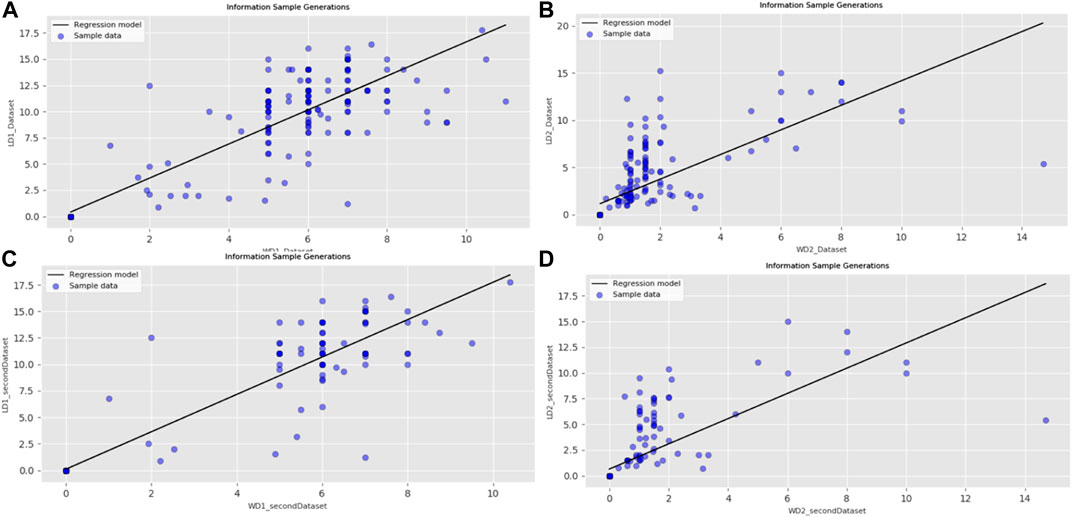
FIGURE 7. Examination of plan data frequency, Source: Author: (A) 1 Frequency of ground floor plan data house number, (B) 2 Frequency of ground floor plan data house number, (C) 1 Frequency of first floor plan data house number, (D) 2 Frequency of first floor plan data house number.
Therefore, according to the diagrams illustrated by Python, the two diagrams a and b, which are related to the ground floor plans, and the c, d diagrams, which are related to the plans with the first floor, show their vertical and horizontal axes, respectively. It gives the length and width of the sample of the studied plans and constituent spaces, which are indicated by the abbreviation LD, WD. The direction of the line indicates a positive correlation between the movement of plans and the space of harvested plans. Considering their age, about 30–100 years, they have increased in frequency and dimensions over time and from the least space to most of the space is inclined. Also, in these diagrams, the presence of colored circles indicates the pattern of 150 cells studied, and the bolder and overlapping pigments indicate the abundance of redundant data and patterns in that range. For this purpose, according to plans selected with the help of Boxplot and the studies performed in the abundance of its data, the plan of 48 rural plains is one of the most frequent patterns. According to the vector-matrix, their width is 5–7 m and their length is 8–15 m.
Similarities of Plans
After reviewing and selecting repetitive patterns, the coding process will be coded on the selected plans. Therefore, by choosing the 48 plans with a repetitive pattern, each plan is compared with 47 others by spatial dimensions and percentage similarity. “Figure” is written. In Figure 8A similarity of the plans, less than 70% similar to each other, is marked separately with the letter NaN.
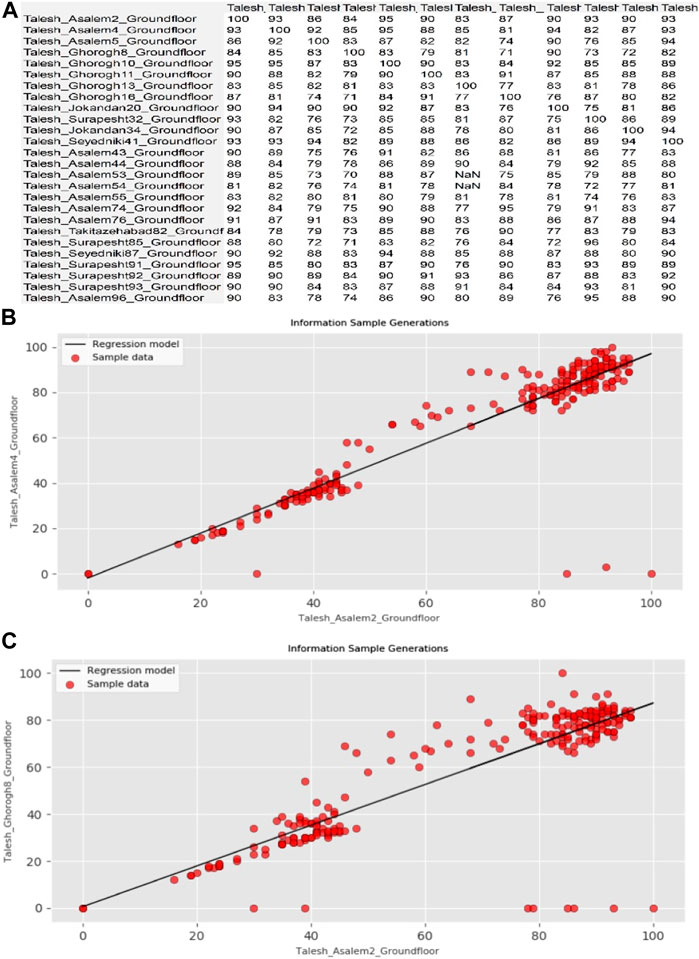
FIGURE 8. (A) Part of the percentage similarity matrix of plans (B,C) Illustrating the percentage of similarity of 48 plans with each other Source: Author.
The study of the percentage similarity matrix of the planes illustrated by Python was used to obtain repetitive patterns with a similarity of over 70%. According to Figures 8B,C, the comparison of the similarity of planes with each other is illustrated by linear regression. The horizontal and vertical axes represent the number 0–100% similarity. The higher the circles on the line, the higher the similarity of planes and the lower the percentage of similarity (Figures 8B,C). This study shows that among the 48 repetitive patterns, 80% of the plans were more than 70% similar to each other.
Finally, as shown in Table 4, according to the minimum and maximum dimensions of the spaces that make up the 48 common patterns obtained from the study of the dimensions of the spaces that make up the rural houses of the Gilan plains, the plans are categorized as The tree diagram is illustrated with the Python programming language.
Plans No. 24, 25, 22 and 26 are in the same category because of their high similarity in their structure, and other plans are also classified in this way (Figure 9). The similarity percentage is obtained from the similarity of the dimensions and size of each plan’s spaces in its structure. It consists of two main categories and 8 sub-categories. The main category plans in the studied plain houses include single-story and Telar plans. Based on the spatial dimensions of the repetitive plans, the hall houses have dimensions with a length of 3–12 m and a width of 5–7.50 m. Its single-story houses are in the dimension range of 5–8 with a width of 3.50–12 m.
Also, by examining the percentage similarity of the plan of the main categories according to the extracted matrix (Figure 8). it can be stated that single-story houses have more than 70% similarity with each other except for repetitive patterns, Is in this area.
Conclusion
Considering that each geographical region has its climate, culture, etc., which differentiates that region from other regions, housing construction in each region also needs its pattern. For this reason, modeling from other regions has increased the consumption of non-renewable energy, which in addition to economic aspects, increases environmental pollution. Adaptation of housing to environmental conditions also brings comfort to residents. Therefore, the necessity of using local architectural methods and physical elements of these houses can be considered according to the region’s climate in the rural context today. Therefore, after examining the form of the plans, what was extracted in this study is the existence of over 75% similarity in the repetitive plans, which indicates a similar course in the design of the rural houses of Talesh.
In the present study, the study results of 150 rural houses in Talesh have been studied based on the percentage of similarity of dimensions and size of plans and comparative observation of patterns. The results show that houses are often affected by climatic characteristics and types of livelihood activities of local people. These houses have an axial and linear form with a rectangular plan and, in most cases, are rectangular in shape and have a length of 5–7.5 and a width of 3–12.5. In these houses, porches and sloping roofs have played an influential role in forming their form. Moreover, the houses were usually directly connected to their external space, such as a passage by creating a continuous columnar porch around their space. The passage and its interior spaces were also related to the external space. They were designed and built. The porch space, a semi-open space in the southern part, has been moved to the middle of most buildings in the contemporary era and provides access to the rooms only for a corridor (Figure 10A).
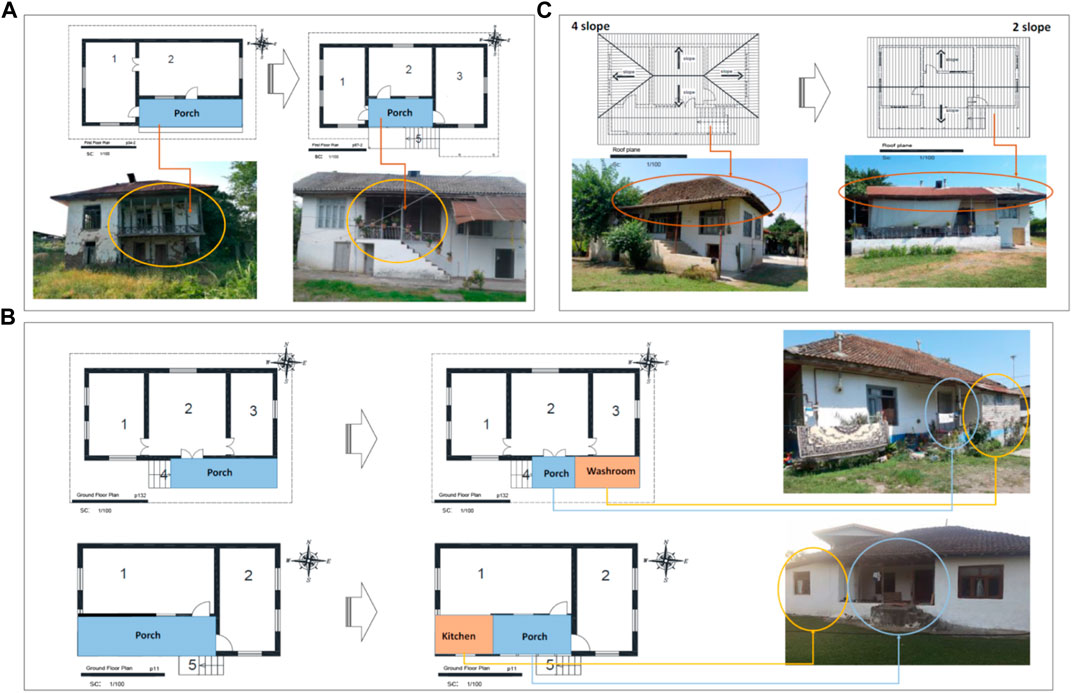
FIGURE 10. Changes made to the form of houses (A) Moving the porch to the central part (B)Transfer of service space to the porch and (C) Deformation of the ceilings in the contemporary era, Source: Authors.
In some cases, as shown in Figure 10B, part of the service space, such as toilets, has been moved from the yard to the porch space and its length has been reduced.
In this building, where the roofs are sloping (mostly 4 slopes) and its protrusion is the size of a porch to prevent rainfall from colliding with the body of the building, in the contemporary era, more use of Aleppo and deformation in the form of 2 slopes Is given (Figure 10C).
Also, by examining 48 repetitive plans with a high percentage of similarity, it shows that Gilan plain houses are generally composed of two categories of common patterns. The main categories are single-story houses and Telar houses (porches upstairs). According to the similarity performed, high-rise houses in these areas are the most frequent patterns (Figure 11A).
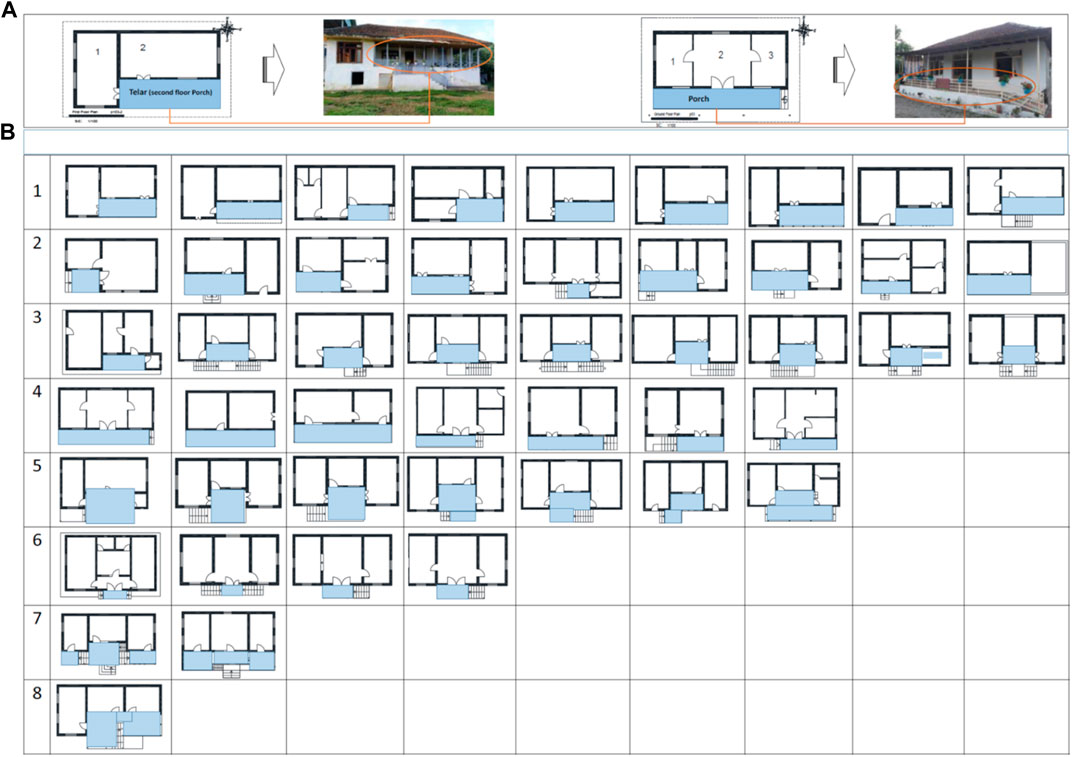
FIGURE 11. Classification of houses (A) An example of a single-story house and Tellar house (B) Classification of form and location of porches, Source: Authors.
It should be noted that considering that the porch is the central core of the architecture of houses in this area, by reviewing 48 repetitive plans, the main category houses according to the shape and location of the porch, are also composed of 8 sub-categories, which in Figure 11B Shown. It should be noted that on the ground floor of the building, in two-story houses, it has been used more as a warehouse and storage place for food, and in some cases as a kitchen, which in recent times has become more of a residence. Also, in Telar houses, the direction of the ground floor rooms is not in the same direction as the upper floor rooms, and the number of spaces on the ground floor is more than the upper floor. Windows in these areas, which have provided natural ventilation to the building on all four sides of the building many times a year, are fewer on the ground floor than on the upper floor (Bazen and Bromberje, 1986; Bromberjeh, 1991; Elsayed et al., 2014; Mazandzani and Reza, 2009; Kasmaei, 2006; Al Qady and Kandil, 2014; Apoorva et al., 2018; Rodrigues et al., 2013; Rodrigues et al., 2014; Su and Yan, 2015; Torkashvand and Raheb, 2015; Verma and Thankur, 2010).
Data Availability Statement
The original contributions presented in the study are included in the article/Supplementary Materials, further inquiries can be directed to the corresponding author.
Author Contributions
SG: Literature review, data collection, paper draft, Visualization MY: Methodology, final editing, Validation MB: data primery analysis.
Conflict of Interest
The authors declare that the research was conducted in the absence of any commercial or financial relationships that could be construed as a potential conflict of interest.
Publisher’s Note
All claims expressed in this article are solely those of the authors and do not necessarily represent those of their affiliated organizations, or those of the publisher, the editors and the reviewers. Any product that may be evaluated in this article, or claim that may be made by its manufacturer, is not guaranteed or endorsed by the publisher.
References
Al Qady, M., and Kandil, A. (2014). Automatic Clustering of Construction Project Documents Based on Textual Similarity. Autom. Constr. 42, 36–49. ISSN 09265805. doi:10.1016/j.autcon.2014.02.006
Al-Hesabi, M., and Raheb, G. (2009). Pathology of Villagers' Attention to the Natural Environment and Environmental protection in Housing Construction (Case Study: Rural Settlements of Gilan Province), Science and Environment. spring. sixth year, third issue.
Apoorva, R., Deekshitha, A., and Jamadade, S. (2018). A Survey on Artificial Intelligence(window to Mankind). Delhi, India: International Journal of Engineering Research&Technology. 2278-0181.
Ashtari, B., Yeganeh, M., Bemanian, M., and Vojdani, B. (2021). A Conceptual Review of the Potential of Cool Roofs as an Effective Passive Solar Technique: Elaboration of Benefits and Drawbacks. Front. Energy Res. doi:10.3389/fenrg.2021.738182
Architects, G. (2005). Introduction to Iranian Residential Architecture: Extrovert Typology. Tehran: Soroush Danesh.
Basiago, A. (1999). Economic Social and Environmental Sustainability in Development Theory and Urban Planning Practice. the environmentalist 2, 145–161. doi:10.1023/A:1006697118620
Bayegi, F., Yeganeh, M., and Sargazi, A. (2018). Evaluation of Environmental Quality Components on Satisfaction, Delight and Behavior Intentions of Customers (Case Study: Gorgan Restaurants). Am. J. Res. 56 (5–6), 84–99. doi:10.26739/2573-5616-2018-3-2-10
Bazen, M., and Bromberje, C. (1986). Gilan and East Azerbaijan. Tehran: Toos Publications. translated by Mozaffaramin Farshchian.
Bromberjeh, K. (1991). Housing and Architecture in Rural Society of Gilan (Anthropological Studies). the first edition. Tehran: Institute of Cultural Studies and Research in collaboration with Gilan Governorate. translated by Aladdin Gosheghir.
Elsayed, S. M., Sarkar, R. A., and Essam, D. L. (2014). A New Genetic Algorithm for Solving Optimization Problems. Elsevier. doi:10.1016/j.engappai.2013.09.013
Haji Ebrahim Zargar, A. (1999). Introduction to Rural Architecture of Iran. Tehran, Iran: Tehran Shahid Beheshti University.
Hassanpourrmarr, S. (2014). Typology of Traditional Houses in Talesh City Case Study: Khaleh-Sara Village 57. Tehran, Iran: housing and village environment. No. 147.
Hillier, B., and Hanson, J. (1984). The Social Logic of Space. Cambridge, New York: Cambridge University Press. Available at http://dx.doi.org/10.1017/CBO9780511597237.
Khakpour, M. (2005). Indigenous Housing in Rural Communities of Gilan, Tehran. J. Fine Arts 22, 62–72.
Khakpour, M. (2007). Architecture of Houses in Gilan; Encyclopedia of Culture and Civilization. Tehran, Iran: Rasht - Ilia Culture.
Mashhadi, A., and Aminpour, A. (2018). Compilation of the Process and Effective Indicators of Architectural Orthography with the Criterion of Compositional Features (Case Study: Historical Buildings of Ararak), 48. Tehran, Iran: Urban Management, 186–173.
Mazandzani, H., and Reza, M. (2009). House, Culture, Nature: A Study of the Architecture of Historical and Contemporary Houses to Develop the Process and Criteria of House Design. Tehran: Architecture and Urbanism Research and Development Center.
Memarian, G. H., and Dehghani Tafti, M. (2018). Seeking to Find Anovel Concept to Type and Typology in Architecture(case Study: Vernacular Houses in Taft,type of Tallardar). J. House Rural Environ. 37 (162), 21–38.
Motevalian, N., and Yeganeh, M. (2020). Visually Meaningful Sustainability in National Monuments as an International Heritage. Sust. Cities Soc. 60, 102207. doi:10.1016/j.scs.2020.102207
Norouzi, M., Yeganeh, M., and Yusaf, T. (2021). Landscape Framework for the Exploitation of Renewable Energy Resources and Potentials in Urban Scale (Case Study: Iran). Renew. Energy Elsevier 163, 300–319. doi:10.1016/j.renene.2020.08.051
Raheb, G. (2016). Analysis of the Concept of "species" in Native Housing and Explaining an Approach to the Classification of Rural Species in Iran. Tehran, Iran: housing and rural environment. No. 150.
Rodrigues, E., Gaspar, A. R., and Gomes, Á. (2014). Automated Approach for Design Generation and thermal Assessmentof Alternative Floor Plans. Energy and Buildings 81, 170–181. doi:10.1016/j.enbuild.2014.06.016
Rodrigues, E., Gaspar, A., and Gomes, A´. (2013). An Evolutionary Strategy Enhanced with a Local Search Technique for the Space Allocation Problem in Architecture, Part 1: Methodology. Computer Aided-Design 45 (5), 887–897. doi:10.1016/j.cad.2013.01.001
Rodrigues, E., Sousa-Rodrigues, D., Teixeira de Sampayo, M., Gaspar, A. R., Gomes, Á., and Henggeler Antunes, C. (2017). Clustering of Architectural Floor Plans: A Comparison of Shape Representations. Automation in Construction 80, 48–65. doi:10.1016/j.autcon.2017.03.017
Sartipipour, M. (2011). Phenomenology of Rural Housing. Tehran, Iran: Housing and Rural Environment. No 133.
Stouffs, R., and Tuncer, B. (2015). Typological Descriptions as Generative Guides for Historical Architecture. Nexus Netw. J. Architecture Math. 17, 785–805. doi:10.1007/s00004-015-0260-x
Su, Z., and Yan, W. (2015). A Fast Genetic Algorithm for Solving Architectural Design Optimization Problems. Cambridge University Press. Published online by.
Torkashvand, A., and Raheb, G. (2015). Typology of Rural Housing in Gilan Province, Housing Foundation of the Islamic Revolution. First edition.
Tusi Hoda, I., and Iraj, E. (2019). Analysis of Industrial Heritage Architecture Using Typology and Grammatical Method of the Analytical Form (Case Study of Isfahan and Vizd Textile Factories). Naghsh Jahan Q. 9 (1), 1–12.
Verma, M., and Thankur, M. (2010). Architectural Space Planning Using Genetic Algorithms. Chengdu, China: IEEE.
Yaran, A., and Khoshbin, H. M. (2019). Strategies for Housing Development in Small Cities Case Study: Shahr-E Khomem in Gilan Province. Scientific J. Bagh-e Nazar 16 (78), 15–26.
Yeganeh, M. (2017). Intergenerational Semiotic Discourse as a Methodological Approach in Identity Transforming of Islamic Cities. Concordia University: Revival of knowledge in the Muslim World: Methodological Approaches.
Yeganeh, M. (2020). Conceptual and Theoretical Model of Integrity between Buildings and City. Sust. Cities Soc. 59, 102205. doi:10.1016/j.scs.2020.102205
Keywords: typology, talesh rural houses, indigenous architecture, plan geometry, historic
Citation: Ghanbari S, Yeganeh M and Reza bemanian M (2022) Architecture Typology of Rural Plain Houses Based on Formal Features, Case Study: (Talesh, Iran). Front. Built Environ. 8:856567. doi: 10.3389/fbuil.2022.856567
Received: 17 January 2022; Accepted: 03 March 2022;
Published: 18 May 2022.
Edited by:
Haidong Wang, University of Shanghai for Science and Technology, ChinaReviewed by:
Luciano Cardellicchio, University of New South Wales, AustraliaSilvana Bruno, Politecnico di Bari, Italy
Copyright © 2022 Ghanbari, Yeganeh and Reza bemanian. This is an open-access article distributed under the terms of the Creative Commons Attribution License (CC BY). The use, distribution or reproduction in other forums is permitted, provided the original author(s) and the copyright owner(s) are credited and that the original publication in this journal is cited, in accordance with accepted academic practice. No use, distribution or reproduction is permitted which does not comply with these terms.
*Correspondence: Mansour Yeganeh, eWVnYW5laEBtb2RhcmVzLmFjLmly
 Sousan Ghanbari1
Sousan Ghanbari1 Mansour Yeganeh
Mansour Yeganeh
